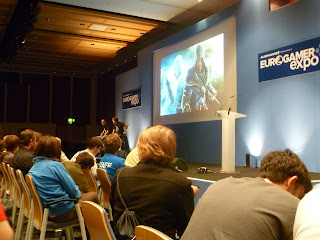 The Ubisoft developer’s conference which took place on Saturday, September 25th 2011 at Earl’s Court was, to say the least, an inspiring one. Showcasing the next instalment in the Assassin’s Creed series, subtitled Revelations, Ubi developers Brent Ashe and Raphael Lacoste teased an early gameplay sequence whilst also introducing us to the core themes of the game.
The Ubisoft developer’s conference which took place on Saturday, September 25th 2011 at Earl’s Court was, to say the least, an inspiring one. Showcasing the next instalment in the Assassin’s Creed series, subtitled Revelations, Ubi developers Brent Ashe and Raphael Lacoste teased an early gameplay sequence whilst also introducing us to the core themes of the game.This is Ezio Auditore’s pièce de résistance; a closing chapter on the protagonist we’ve spent the past two instalments dealing with. But Revelations also brings back old flame Altair, star of the series’ inception into videogame lore, in a subtle yet ingenious move by Ubisoft. By involving two alternate characters, two highly contrasting milieus are afforded to the player, with exceptional results. It’s a lot more work for Ubisoft’s art directors, but it’s certainly rewarding.
Ezio’s older now - “he’s wiser and more focused,” said Ashe of the returning assassin. “He’s a lot more like Altair now; he never wanted to be an assassin, but now he is and he’s a lot more focused and driven than we saw in the past two games.” Put simply, Ezio’s grown up. And this is, according to Lacoste, partly down to his extensive travels over the years between previous instalment Brotherhood and November’s Revelations - from clothing items he’s collected to more personal changes.
Yes, apparently Ezio’s been on a bit of a soul-searching journey. “He’s been travelling, but it’s not just been a physical journey, it’s also been on a personal level.” Ashe states, suggesting Ezio’s newfound maturity is down to a more enlightened level of thinking. “He’s been looking inside himself and looking back over his life and how it turned out like that.” So Ezio’s back, but it’s not the Ezio we once knew.
To touch upon the gameplay element for a moment; one striking moment during a battle between Ezio and Templar agents sees a ghostly shadow of Altair appear in the foreground, turning and walking away. This connection between the two ancestors of present-day protagonist Desmond is the central theme of Revelations; the game’s story, as per the title, will offer some narrative closure to players after three chapters of mystery and codes, tying up Ezio and Altair’s respective stories. Here’s hoping a full-blown sequel, with new settings and characters, is lined up for 2012/3.
After a narrow escape, we see the aged Italian fleeing in a carriage, pursued in force by Templar agents. Ashe promises the entire sequence will be playable in the final game, but for now it’s a rather lovely cinematic. The lighting and textures have also improved since last year’s Brotherhood, and it’s quite noticeable. Lacoste’s artistic team have developed a huge new sandbox to play in across the Ottoman Empire, from Masyaf to Constantinople, where Revelations eventually takes our vigilante hero.
Ubisoft have also integrated a range of new gameplay mechanics, from a ‘hook blade’ tool that blends combat and navigation - think zip-wires and aerial attacks - to an enhanced Eagle Vision that allows Ezio to see his target’s path. Also new to the Creed series is the ‘bomb factory’; a pouch Ezio carries that allows him to construct his own bombs from various ‘ingredients’ that can either be bought or found (often on corpses). For each bomb, three different factors are decided - type of shell, gunpowder and effect - to assign the weapon into one of three categories; lethal, tactical or diversionary.
Take the Cherry Bomb - a classic diversionary tactic, it’s effectively a grenade thrown to act as a decoy. Of course, one might argue that Assassin’s Creed is straying ever closer to modern weaponry - from Ezio’s projectile firing wrist mechanism in ACII (i.e. his gun) to the grenades and landmines the bomb pouch offers - but the way it’s dressed in the time period, to such great effect, should still keep players completely immersed in the era.
A second spin-off for the Assassin’s Creed series might not be on the priority list for fans of the series, particularly re-using old characters, but its titular promise of answers to some pressing story questions, combined with a refreshing mix of new gameplay elements and beautiful locations, should give players enough to tide them over until the next full blown sequel. For which, by the way, I’d just like to throw out the suggestion of 19th Century Victorian England. Maybe with a brand new female assassin. Anyone?

 Premiering at the 68th Venice International Film Festival
around two weeks prior to general release, Tinker Tailor Soldier Spy was
greeted almost instantly with unanimous critical acclaim. Cries of
sophistication, intelligence, and an astounding, absorbing experience were
bandied around various film institutions; as of this writing, Tinker holds a
97% aggregate on Rotten Tomatoes after thirty five reviews. Just one of those
has been negative, which only begs the question: why?
Premiering at the 68th Venice International Film Festival
around two weeks prior to general release, Tinker Tailor Soldier Spy was
greeted almost instantly with unanimous critical acclaim. Cries of
sophistication, intelligence, and an astounding, absorbing experience were
bandied around various film institutions; as of this writing, Tinker holds a
97% aggregate on Rotten Tomatoes after thirty five reviews. Just one of those
has been negative, which only begs the question: why?







